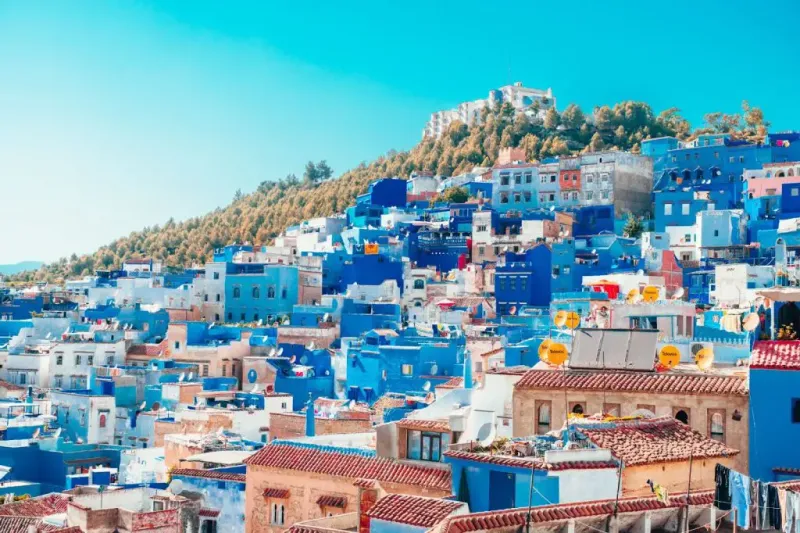Moroccan architecture is a captivating blend of intricate patterns, vivid colors, and historical influences that leave visitors in awe.
From ancient palaces to modern-day marvels, each structure tells a unique story of the country’s rich cultural heritage.
In this article, we’ll explore 10 stunning examples of Moroccan architecture that showcase the country’s architectural prowess.
Each one offers a glimpse into the artistic craftsmanship and design philosophies that have shaped Morocco’s architectural landscape.
1. Hassan II Mosque

The Hassan II Mosque in Casablanca stands as a testament to the grandeur of Moroccan architecture. With its towering minaret reaching 210 meters, it holds the title of the tallest in the world.
The mosque’s stunning mosaics and woodwork showcase the craftsmanship of Moroccan artisans. The mosque is built partly on the water, offering breathtaking views of the Atlantic Ocean.
Visitors are often struck by the play of light across its surfaces, creating a serene atmosphere. It’s not just a place of worship; it’s a masterpiece of design and a symbol of cultural pride.
2. Ksar of Ait Ben Haddou

Perched on a hill, the Ksar of Ait Ben Haddou is a striking example of traditional Moroccan architecture. This ancient fortified village is made of earthen clay and offers a glimpse into a bygone era.
The ksar’s towers and narrow alleys have inspired countless filmmakers and artists. Its historical value is recognized by UNESCO as a World Heritage site.
Walking through its pathways, one can almost hear the echoes of ancient traders. The golden glow at sunset, reflecting off the walls, is a sight to behold for any traveler.
3. Bahia Palace

Nestled in the heart of Marrakech, Bahia Palace is a splendid example of Moroccan opulence. Built in the 19th century, it was designed to be the grandest palace of its time.
The palace boasts lavish gardens and stunning tilework that reflect the artistry of Moroccan craftsmen. Walking through its rooms, visitors are treated to a visual feast of colors and patterns.
The tranquility of its courtyards offers a welcome escape from the city’s hustle and bustle. It’s a must-visit for anyone wanting to experience the grandeur of Moroccan history.
4. Fes el Bali

Fes el Bali, the oldest part of the city of Fes, is a labyrinth of winding alleys and historical treasures. Founded in the 9th century, it is home to the world’s oldest university.
The city is a living museum, with its medina offering a sensory overload of sights, sounds, and smells. Artisans still practice ancient crafts in its bustling souks.
Exploring Fes el Bali, one can discover hidden gems around every corner. It’s a place where history comes alive, and the past seamlessly blends with the present.
5. Majorelle Garden

An oasis in the heart of Marrakech, the Majorelle Garden is a masterpiece of color and tranquility.
Originally created by French painter Jacques Majorelle, it was later restored by fashion designer Yves Saint Laurent.
The garden is famous for its vibrant cobalt blue structures and exotic plant collection. Walking through its paths, visitors are enveloped in a serene and magical atmosphere.
The gentle sound of water and the rustling of leaves create a peaceful retreat. It’s an enchanting spot that showcases the fusion of art and nature.
6. Chefchaouen

Nestled in the Rif Mountains, Chefchaouen is a town unlike any other, famous for its blue-washed streets and buildings. This charming town offers a visual delight and a sense of tranquility.
Walking through its vibrant streets, one feels transported to a serene world of color. The tradition of painting the town blue is said to have spiritual significance.
With its stunning mountain backdrop and friendly locals, Chefchaouen is a photographer’s paradise. It’s a place where beauty meets tradition in a symphony of blue hues.
7. Volubilis

Step back in time at Volubilis, one of Morocco’s most famous archaeological sites. These ancient Roman ruins are a testament to the region’s historical significance.
The site boasts well-preserved mosaics, columns, and arches, offering a glimpse into Roman life in Africa. Its grandeur speaks to a time when Volubilis was a thriving city.
Visitors can wander through the ruins and imagine the bustling streets of the past. Surrounded by fertile lands, the site is a reminder of Morocco’s diverse historical tapestry.
8. Saadian Tombs

Hidden for centuries, the Saadian Tombs in Marrakech were rediscovered in 1917, revealing a treasure trove of historical art. These tombs provide a glimpse into the opulence of the Saadian dynasty.
Adorned with intricate tilework and surrounded by lush gardens, the tombs are a peaceful retreat. Each mausoleum is beautifully decorated, reflecting the craftsmanship of the era.
The serene atmosphere invites reflection and admiration of the past. A visit here is a journey through history, rich in cultural and artistic heritage.
9. The Royal Palace of Rabat

A symbol of Moroccan sovereignty, the Royal Palace of Rabat is a majestic sight to behold. This exquisite complex serves as the residence of the King of Morocco.
The palace’s architecture is a blend of traditional Moroccan and modern styles, reflecting the country’s evolving identity. Its lush gardens and grand courtyards are a testament to the royal family’s taste.
Visitors can admire the exterior and imagine the grandeur within. It’s a place where tradition and modernity coexist, symbolizing Morocco’s progressive spirit.
10. Moulay Idriss Zerhoun

Moulay Idriss Zerhoun is a sacred town that holds a special place in Moroccan hearts. Named after the founder of the first Moroccan state, it’s a site of pilgrimage for many.
Perched on a hill, the town offers stunning views of the surrounding valleys, creating a serene atmosphere. Its whitewashed buildings and narrow streets invite exploration.
The spiritual essence of Moulay Idriss is palpable, making it a must-visit for those seeking cultural depth. It’s a town where history and spirituality are intertwined.

